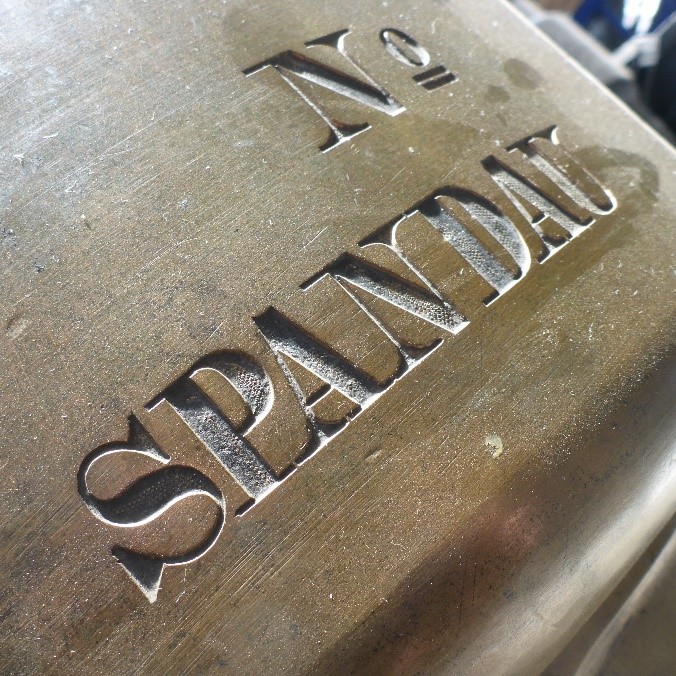Of course, the Spice Islands and Asia aren’t the only places with history and forts. Europe is loaded with both. A while back, on a posting to Berlin I had a look at some of the fortifications there.
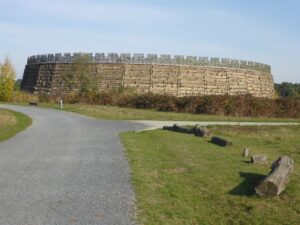
Our first and oldest fortification is not a work designed to mount and resist artillery, but it is an interesting example of a historical re-construction. Slawenburg Raddusch is a replica Slavic ring fort from around 1000 AD built over the ruins of a series of earlier fortified structures, located 90 km south-east from Berlin.
Constructed of a 10m wide circular gridwork of heavy timber beams filled with earth and stones, the work enclosed a circular internal courtyard, and was surrounded by a 6m wide moat.
Ruins of about 40 similar forts are spread across the area, which 1000 years ago was inhabited by a Sorbian tribe called the Lusitzi. They increasingly came under pressure from the expanding Saxon tribes and built these works in response. The ring forts were used as refuges when attackers hove into view, but were otherwise unoccupied. Set around the inner courtyard were dwellings and storehouses, and two entrances equipped with bridges over the moat provided access from outside.
The locality is an hour’s drive from Berlin near the forested canals of the Spreewald and sits atop enormous and very shallow deposits of brown coal. Many of the fort sites were destroyed by huge mining excavators in GDR times, but luckily local archaeologists saved the Slawenburg site just in time. Subsequent digs found fortifications first built here in about 880, and regularly modified and expanded, as the core timber rotted after a few decades and needed replacing.
Today, the replica, which was funded by the mining companies, holds a café and a museum and is worth a look if you are enroute to the Spreewald.
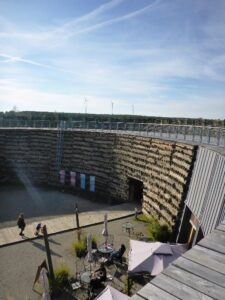
Secondly, moving 500 years forward, we can look at Renaissance Spandau Citadel, on the western edge of the Berlin metropolitan area, guarding the junction where the Spree – on which Berlin sits – joins the Havel, which, flowing into the Elbe, enters the North Sea at Hamburg. It was built on the ruins of previous Slavic fortifications dating from the 11th century, with the four-bastioned square fort that can be seen today dating from the 1560’s. The town of Spandau sat under its guns just across the Havel.
The most visually prominent feature of the Citadel is the Juliusturm, a medieval circular tower that functioned as the fortress ‘keep’ dating from the early 1200’s. Like the rest of the fortress, it is built entirely of red brick. At various times, the Juliusturm was used as a place of refuge, a prison and to store the reparations from France after its 1871 defeat; the 40 million taels of gold safe behind metre thick walls.
The Citadel itself was commissioned by the Elector of the state of Brandenburg, Joachim II, in 1559 as a defensive position and royal refuge. Venetian fortification expert Francesco de Gandino was engaged to design the works, having completed previous forts at Kustrin and Peitz nearby in Brandenburg. A French-trained Tuscan, Count Lynar (who built the citadel at Metz) carried on the design and building works from 1578 to its completion in 1594. The site, at the confluence of the two rivers was swampy and unstable, and so difficult to find bearing material that part of the bastion foundations were built on piles!
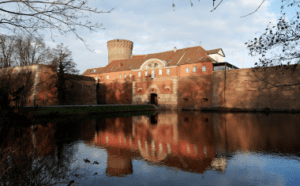
As completed by Lynar, the work had four angled corner bastions approximately 300m point to point with 140m curtains, and was fully moated, with the entry bridge placed adjacent to the south-western bastion. An outer series of connected defences including ravelins, counterguards, and cavaliers extended beyond the moat around most of the perimeter. Today, you can walk these forested outworks, except for ravelin Schweinekopf, which remains an island.
The Citadel was occupied by Sweden for part of the Thirty Years War, but emerged from that conflict much less damaged than most of northern Germany. It was threatened but not conquered by the Austrians in 1757 and 1760, but by 1806 was neglected enough to encourage the Prussian garrison to surrender to Napoleon without resisting. He ordered the defences rebuilt, and the Citadel then suffered heavy damage when the Russians and Prussians retook it in 1813. Rebuilding was completed only in 1843, and by 1903, the outer defences were mostly removed. The complex remained in military use, being used during WWII as a gas warfare laboratory, until May 1945 when it surrendered to Soviet troops.
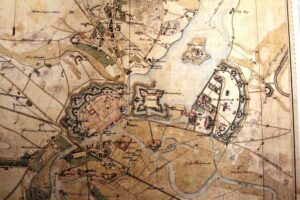
Apart from the corner bastions and Juliusturm, the main internal features today are the Gatehouse/ Commandants House (which contain a museum of the Citadel’s history); the Palas, a medieval Gothic Hall, now used for functions; the 111m long 19th century Old Barracks; the Parade Hall, once the Prussian armoury, now housing an impressive collection of historic artillery; and the attractive Arsenal, which holds a local history museum. A small fortress harbor, a Café, various artist workshops, film studio’s and conference facilities are also located inside. Music festivals and medieval days, complete with jousting competitions are held throughout summer, and concerts, theatre, weddings, functions and conferences all help to fund the ongoing upkeep.
Touted as one of the best-preserved Renaissance fortresses in Europe, it is about 30 minutes by train from central Berlin. The bastions are seldom crowded, the view from the top of the Juliusturm is excellent, and for those into artillery, the Parade Hall is not to be missed.
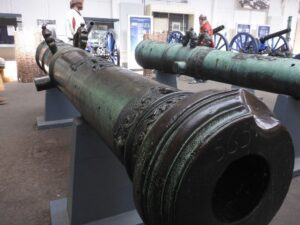
And forward again 500 years from Renaissance Spandau to 20th century Humboldthain Flakturm. Three of these enormous concrete towers were ordered built in Berlin following the first RAF bombing raid on the city in August 1940. They were designed as both an AA platform and as a shelter for civilians. The cavernous, multi-level interior could accommodate up to 20,000 people, safe behind 3.5m thick reinforced concrete walls.
The initial Flakturm project consisted of 3 complexes in central Berlin, at Tiergarten, Friedrichshain and Humboldthain. Each complex was composed of two 40m high towers : one, the 70m x 70m Gun Tower fielding four 128mm rifles; and the second, the 50m x 25m Command Tower with retractable radar and armed with four quad 20mm weapons. The big Rheinmetall flak guns could put a 28kg shell up to 50,000 feet, far above the allied bomber streams.
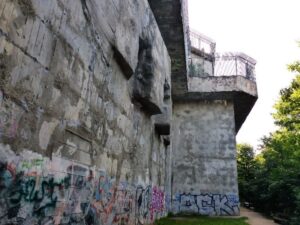
As the bombing campaign against German cities intensified, other towers of differing layouts were built at Hamburg and Vienna, and many more were planned but not constructed. The 3 Berlin Flakturms with their radar, long range weapons and clear fields of fire formed a significant part of the city’s AA defences, but by 1945 they were supported by another 270 88mm and 50 128mm guns.
When the Red Army battled through the Berlin suburbs in May 1945, the flak towers were used as field fortifications; firing their AA guns in anti-tank mode, from structures that were impervious to even the largest Russian guns, and serving as rallying points for the remaining German combat units. Eventually, all three Flakturm’s, packed with civilians, surrendered.
Immediately after hostilities, the Allied powers intended to destroy the three Flakturms. The British blew up the twin towers at Tiergarten (or Zoo), but the quantity of explosives required (35 tons) and the impact of the detonation discouraged the Russians and Americans from carrying out similar demolition at the other locations. At Friedrichshain and Humboldthain, portions of the structures were demolished, but for the most part, the Towers were buried in rubble from destroyed buildings, of which there was no shortage.
Today, Berlin’s Zoo is located on the site of the obliterated Tiergarten Flakturm and just a tiny part of Friedrichshain’s Gun Tower emerges from its rubble mountain in the park of the same name. Humboldthain’s Gun Tower can still be seen however, with two of the 128mm gun platforms accessible after climbing up a now-vegetated hill of destroyed buildings. Because so much of the Tower is buried, the scale of the structure is not clearly apparent, but fascinating tours inside are now possible www.berliner-unterwelten.de from April to October.
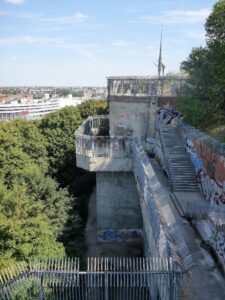
For those with a desire to visit other historic military sights in Berlin, the US spy complex at Teufelsburg (tours available), the Luftwaffe Museum at the old RAF base at Gatow, an abandoned Soviet airbase at Finowfurt (with a decent collection of old Mig’s), and further afield, the Seelow Heights battlefield along the Oder are all worth a look.

